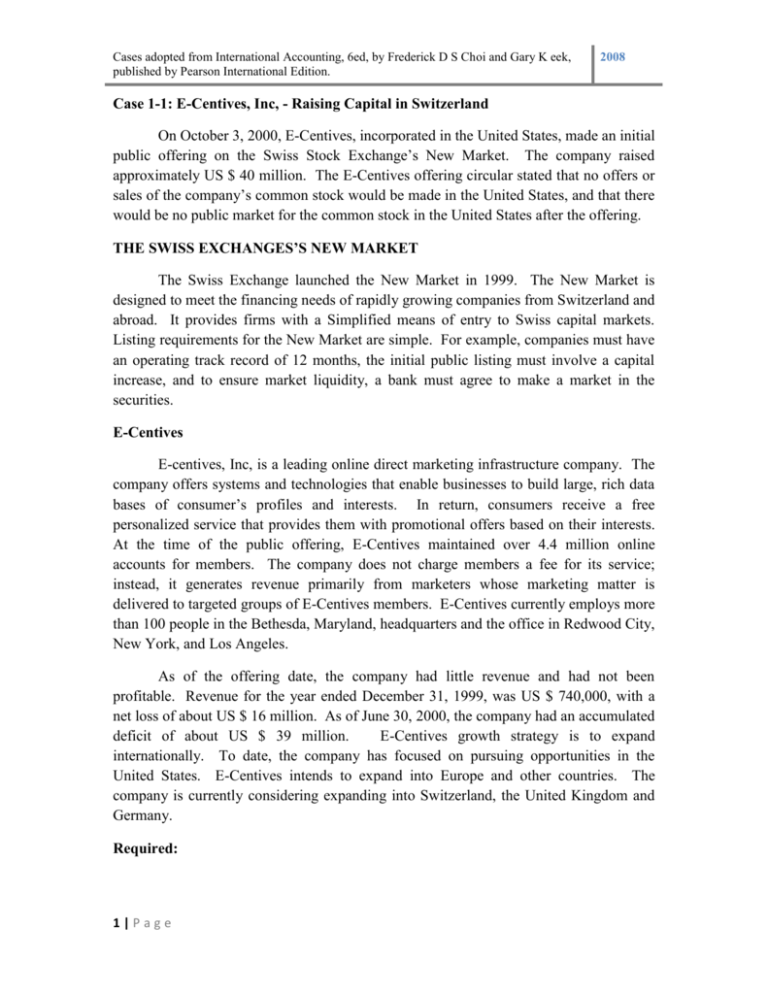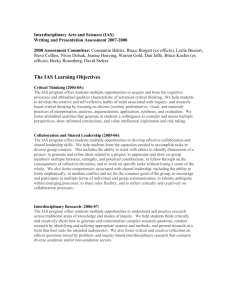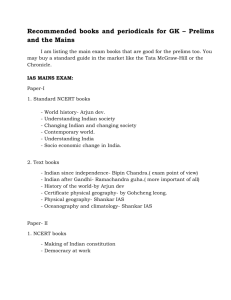Cases adopted from International Accounting, 6ed, by Frederick D S
advertisement

Cases adopted from International Accounting, 6ed, by Frederick D S Choi and Gary K eek, published by Pearson International Edition. 2008 Case 1-1: E-Centives, Inc, - Raising Capital in Switzerland On October 3, 2000, E-Centives, incorporated in the United States, made an initial public offering on the Swiss Stock Exchange’s New Market. The company raised approximately US $ 40 million. The E-Centives offering circular stated that no offers or sales of the company’s common stock would be made in the United States, and that there would be no public market for the common stock in the United States after the offering. THE SWISS EXCHANGES’S NEW MARKET The Swiss Exchange launched the New Market in 1999. The New Market is designed to meet the financing needs of rapidly growing companies from Switzerland and abroad. It provides firms with a Simplified means of entry to Swiss capital markets. Listing requirements for the New Market are simple. For example, companies must have an operating track record of 12 months, the initial public listing must involve a capital increase, and to ensure market liquidity, a bank must agree to make a market in the securities. E-Centives E-centives, Inc, is a leading online direct marketing infrastructure company. The company offers systems and technologies that enable businesses to build large, rich data bases of consumer’s profiles and interests. In return, consumers receive a free personalized service that provides them with promotional offers based on their interests. At the time of the public offering, E-Centives maintained over 4.4 million online accounts for members. The company does not charge members a fee for its service; instead, it generates revenue primarily from marketers whose marketing matter is delivered to targeted groups of E-Centives members. E-Centives currently employs more than 100 people in the Bethesda, Maryland, headquarters and the office in Redwood City, New York, and Los Angeles. As of the offering date, the company had little revenue and had not been profitable. Revenue for the year ended December 31, 1999, was US $ 740,000, with a net loss of about US $ 16 million. As of June 30, 2000, the company had an accumulated deficit of about US $ 39 million. E-Centives growth strategy is to expand internationally. To date, the company has focused on pursuing opportunities in the United States. E-Centives intends to expand into Europe and other countries. The company is currently considering expanding into Switzerland, the United Kingdom and Germany. Required: 1|Page Cases adopted from International Accounting, 6ed, by Frederick D S Choi and Gary K eek, published by Pearson International Edition. 2008 1. Refer to Exhibit 1-9, which lists factors relevant for choosing an overseas market for listing or raising capital. Which factors might have been relevant in ECentives’ decision to raise capital and list of the Swiss Exchange’s New Market? 2. Why do you believe E-Centives chose not to raise public equity in the United States? What are the potential drawbacks related to the decision not raise capital in the U.S. public markets? 3. What are the advantages and disadvantages for E-Centives of using U.S. GAAP? 4. Should the SWX Swiss Exchange require E-Centives to prepare its financial statements using Swiss accounting standards? 5. Learn more about the new market at SWX Exchange’s web site (www.swx.com). What are the listing requirements for the New Market? What are the financial reporting requirements? Does E-Centives appear to fit the profile of the typical New Market Company? Case 1-2: Global Benchmarks: Infosys Technologies Limited Investors, whether individual, corporate, or institutional, are increasingly investing beyond national borders. The reason is not hard to find. Returns abroad, even after allowing for foreign currency exchange risk, often exceed those offered by domestic investments. Information provided in a firm’s annual report is often the major source of information available to those seeking to sample foreign equities. In attempting to assess the risk and return attributes of a given company, readers must attributes of a given company, readers must answer questions like the following: What accounting principles were employed? Would the financial statements be more useful if restated to a different set of accounting principles? What types of information are not provided that one would expect to find in financial statements of companies from the investor’s home country? How would one compensate for limited disclosure? What does the audit report reveal about the level of audit quality? What auditing standards were used? Are they acceptable? Does the audit report mean the same thing as it does in the reader’s home country? Appendix 1-3 refers you to the financial statements (including selected notes) and auditor’s report for Infosys Technologies Limited. Infosys was incorporate in 1981 as Infosys Consultants Private Limited, a private company under the Indian Companies Act. Its name eventually evolved into Infosys Technologies Limited in 1992, when the company went public. Its mission is to provide high-quality and cost-competitive technology solutions for companies around the world. It has grown into a $ 2 billion company with a market capitalization in excess of $ 21 billion. In examining the information referred to in Appendix 1-3, comment on how the statements of Infosys stack up to other companies in the industry in meeting the information needs of a non-domestic investor such as you. Specifically: What reporting 2|Page Cases adopted from International Accounting, 6ed, by Frederick D S Choi and Gary K eek, published by Pearson International Edition. 2008 practices raise issue for you? What reporting practices do you find helpful? In preparing your critique, compare the reporting practices of Infosys to a service provider in your country that maintains a corporate Web site on the Internet. Case 2-1: Are Classifications of Accounting Outmoded? Consider the following statements by David Cairns, former secretary-general of the International Accounting Standards Committee. When we look at the way that countries or companies account for particular transactions and events, it is increasingly difficult to distinguish in a systematic way so called Anglo-American accounting from Continental European Accounting orr American accounting from, say, German accounting. I am increasingly persuaded … that the distinction between Anglo-American accounting and Continental European accounting is becoming less and less relevant and more and more confused. In reaching this conclusion, I do not dispute that different economic, social and legal considerations have influenced the development of accounting in different countries. I also do not dispute the fact that there have been, and still are, differences in the means by which different countries determine accounting requirements and the forms of the resulting requirements. I do believe, however, that those who continue to favour these classifications are ignoring what is happening in the world and how companies actually account for transactions and events. It is increasingly apparent that the different economic, social and legal considerations which have influenced national accounting do not necessarily result in different accounting and that countries are reaching the same answers irrespective of their different cultural backgrounds (or reaching different answers in spite of the similar cultural back grounds). In fact, there are now probably far more similarities between American and German accounting than there are between American and British accounting. There are many reasons for this not least the increasing practice of standard setting bodies and other regulators to share ideas and learn from one another. They do this in the IASC, the UN, the OECD, the EU and such groupings as G4. This crossfertilization of ideas is not surprising because standard setting bodies in all countries are having to address the same accounting problems. Required: 1. Do you agree with Cairns’s assertion that classifications of accounting are simplistic and of little relevance in today’s world? Are attempts to classify accounting futile and outmoded? Why or why not? 2. Some observers contend that financial reporting is becoming more and more alike among “world-class” companies – the world’s largest multinational corporations 3|Page Cases adopted from International Accounting, 6ed, by Frederick D S Choi and Gary K eek, published by Pearson International Edition. 2008 – and especially those listed on the major stock exchanges, such as London, New York and Tokyo. What is the relevance of this contention for classification of accounting, and what are the factors that would cause this to happen? Case 2-2: Volkswagen Group The Volkswagen Group adopted International Accounting Standards (IAS, now International Financial Reporting or IFRS) for its 2001 fiscal year. The following is taken from Volkswagen’s 2001 annual report. It discusses major differences between the German Commercial Code (HGB) and IAS as they apply to Volkswagen. GENERAL In 2001 VOLKSWAGEN AG has for the first time published its consolidated financial statements in accordance with International Accounting Standards (IAS) and the interpretations of the Standing Interpretations Committee (SIC). All mandatory International Accounting Standards applicable to the financial year 2001 were complied with. The previous year’s figures are also based on those standards. IAS 12 (revised 2000) and IAS 39, in particular, were already complied with in the year 2000 consolidated financial statements. The financial statements thus give a true and fair view of the net assets, financial position and earning performance of the Volkswagen Group. The consolidated financial statements were drawn up in Euros. Unless otherwise stated, all the amounts are quoted in millions of Euros (million €). The income statement was produced in accordance with the internationally accepted cost of sales method. Preparation of consolidated financial statements in accordance with IAS requires assumptions regarding a number of line items that affect the amount entered in the consolidated balance sheet and income statement as well as the disclosure of contingent assets and liabilities. The conditions laid down in Section 292a of the German Commercial Code (HGB) for exemption from the obligation to draw up consolidated financial statements in accordance with German commercial law are met. Assessment of the said conditions is based on German Accounting Standard No. 1 (DSR 1) published by the German Accounting Standards Committee. In order to ensure equivalence with consolidated financial statements produced in accordance with German commercial law, all disclosures and explanatory notes required by German commercial law beyond the scope of those required by IAS are published. 4|Page Cases adopted from International Accounting, 6ed, by Frederick D S Choi and Gary K eek, published by Pearson International Edition. 2008 TRANSITION TO INTERNATIONAL ACCOUNTING STANDARDS The accounting valuation and consolidation methods previously applied in the financial statements of VOLKSWAGEN AG as produced in accordance with the German Commercial Code have been amended in certain cases by the application of IAS. Amended accounting, valuation and consolidation methods in accordance with the German Commercial Code Tangible assets leased under finance leases are capitalized, and the corresponding liability is recognized under liabilities in the balance sheet, provided the risks and rewards of ownership are substantially attributable to the companies of Volkswagen Group in accordance with IAS 17. As a financial lease lessor, leased assets are not capitalized, but the discounted leasing installments are shown as receivables. Movable tangible assets are depreciated using the straight-line method instead of the declining balances method; no half-year or multi-shift depreciation is used. Furthermore, useful lives are now based on commercial substance and no longer on tax law. Special depreciation for tax reasons is not permitted with IAS. Goodwill from capital consolidation resulting from acquisition of companies since 1995 is capitalized in accordance with IAS 22 and amortized over its respective useful life. In accordance with IAS 2, inventories must be valued at full cost. They were formerly capitalized only at direct cost within the Volkswagen Group. Provisions are only created where obligations to third parties exist. Differences from the translation of financial statements produced in foreign currencies are not recorded in the income statement. Medium and Long-term liabilities are entered in the balance sheet including capital take-up costs, applying the effective interest method. Amended accounting, valuation and consolidation methods that differ from the German Commercial Code In accordance with IAS 38, development costs are capitalized as intangible assets provided it is likely that the manufacture of the developed products will be of future economic benefit to the Volkswagen Group. Pension provisions are determined according to the Projected Unit Credit Method as set out in IAS 19, taking account of future salary and pension increase. Provisions for deferred maintenance may not be created. Medium and long-term provisions are shown at their present value. 5|Page Cases adopted from International Accounting, 6ed, by Frederick D S Choi and Gary K eek, published by Pearson International Edition. 2008 Securities are recorded at their fair value, even if this exceeds costs, with the corresponding effect in the income statement. Deferred taxes are determined according to the balance sheet liability method. For losses carried forward deferred tax assets are recognized, provided it is likely that they will be usable. Derivative financial instruments are recognized at their fair value, even if is exceeds cost. Gains and losses arising from the valuation of financial instruments serving to hedge future cash flows are recognized by way of a special reserve in equity. The profit or loss from such contracts is not recorded in the income statement until the corresponding due date. In contrast, gains and losses arising from the valuation of derivative financial instruments used to hedge balance sheet items are recorded in the income statement immediately. Treasure shares are offset against capital and reserve. Receivables and payables denominated in the foreign currencies are valued at the middle rate of the balance sheet date, and not according to the imparity principle. Minority interests of shareholders from outside the Group are shown separately from capital and reserve. The adjustment of the accounting and valuation policies to International Accounting Standards with effect from January 1, 2000 was undertaken in accordance with SIC 8, with no entry in the income statement, as an allocation to or withdrawal from revenue reserves, as if the accounts had always been produced in accordance with IAS. The reconciliation of the capital and reserves to IAS is shown in the following table: Capital and reserve according to the German Commercial code as at January 1, 2000 Capitalization of development costs Amended useful lives and depreciation methods in respect of tangible and intangible assets Capitalization of overheads in inventories Different treatments of leasing contract as lessor Differing valuation of financial instruments Effect of deferred taxes Elimination of special items Amended valuati9n of pension and similar obligations Amended accounting treatment of provisions Classification of Minority interests not as part of equity Other changes Capital and reserves according to IAS as at January 1, 2000 Source: Volkswagen AG Annual Report 2001, pp. 84-86 6|Page Million € 9,811 3,982 3.483 653 1,962 897 -1,345 262 -633 2,022 -197 21 20,918 Cases adopted from International Accounting, 6ed, by Frederick D S Choi and Gary K eek, published by Pearson International Edition. 2008 Required: 1. Based on the information provided in the chapter, describe the basic features of German accounting at the time Volkswagen adopted IAS. What developmental factors cause these features? 2. What differences between the accounting requirements in the HGB and IAS are highlighted in Volkswagen’s disclosure? Are the German requirements consistent with your characterizations in the requirement 1? 3. What is the relevance of Volkswagen’s adoption of IAS to the classifications studied in this chapter? 7|Page







